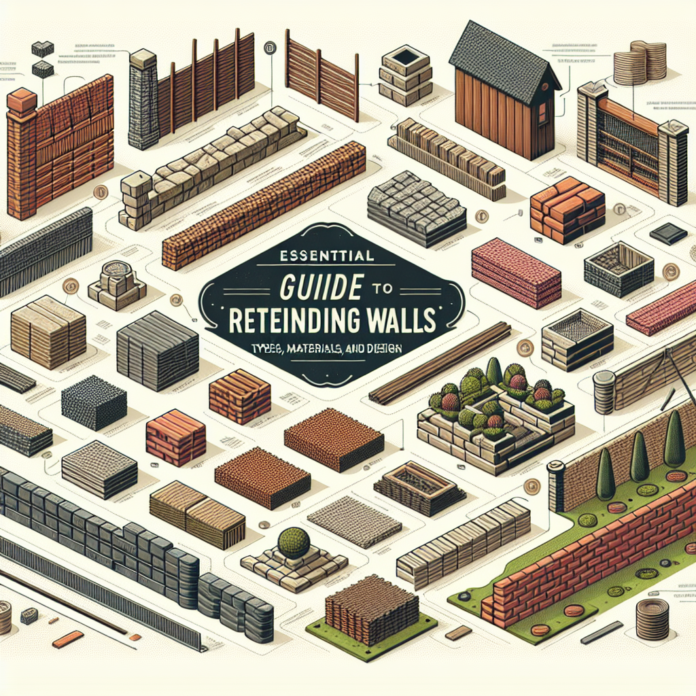The construction of retaining walls is a crucial aspect of landscaping and building projects. They are designed to hold back soil or landscape, reducing erosion and soil displacement, especially in areas with sloping elevations or uneven terrain. In this comprehensive guide, we will explore everything you need to know about retaining walls – their types, materials used, and design principles. This article aims to provide a deeper understanding and appreciation of the importance, functionality, and aesthetics of retaining walls.
Types of Retaining Walls
Retaining walls can be classified into several types based on their design and the way they resist loads.
Gravity Retaining Walls
As the name implies, this type of wall relies on its weight and the force of gravity to resist the pressure from the earth it supports. These walls are thicker at the base and gradually taper toward the top. Common materials used for gravity retaining walls include stone, concrete, and brick.
Cantilever Retaining Walls
Cantilever retaining walls are constructed of reinforced concrete. They consist of a relatively thin stem and a base slab that is divided into two parts: the heel (located under the backfill) and the toe (the other part of the base). In terms of strength and durability, cantilever retaining walls are superior to gravity walls and can withstand greater loads.
Sheet Piling Walls
This type of retaining wall is typically used in tight spaces or for softer soils. The wall, usually made of steel, vinyl, or wood planks, is driven directly into the soil. Sheet piling walls work best in areas where the water table is high.
Anchored Retaining Walls
An anchored retaining wall is similar to other types but includes additional strength-boosting elements called anchors. These are driven into the material behind the wall and then expanded, adding extra resistance to pressure.
Materials Used in Retaining Walls
Beyond the type of the wall, the material used in its construction significantly influences both the design and functionality of the wall. Following are some of the most commonly used materials in the construction of retaining walls:
Concrete
Concrete is a popular and versatile material for retaining walls. It can be molded into various forms and shapes and is highly customizable. Precast concrete products, such as blocks or concrete masonry units, are the common choice for DIY retaining wall projects due to their ease of installation.
Natural Stone
Natural stone offers numerous choices in color, texture, and form. A natural stone retaining wall can blend in with its surroundings, enhancing the natural beauty of the landscape while providing structural stability.
Brick
Brick is a timeless and durable material for retaining walls. It adds elegance and aesthetics to any landscape while also offering solid strength and longevity when properly constructed. Maintenance is relatively easy, making it a popular choice for many homeowners.
Wood
Wooden retaining walls provide a rustic look and feel. While not as durable as stone or concrete, they serve well in many landscape designs, particularly in natural and rustic settings. However, they require more maintenance and are not as long-lasting as other materials.
Design Principles of Retaining Walls
Designing a retaining wall involves an understanding of balance, strength, and stability. The size, shape and material choice must all be determined based on the load it has to resist. Additionally, it’s essential to take into consideration the moisture management and drainage systems, as uncontrolled water can negatively impact structural integrity. In terms of aesthetics, the design should also complement its surroundings, matching the overall theme and style of the landscape.
Conclusion
Retaining walls are a vital part of many construction and landscaping endeavours. Understanding the different types, the materials used, and the design principles can significantly aid in choosing the appropriate retaining wall for your specific project. It’s always important to consult with a professional to make informed decisions about retaining wall construction, as it involves significant safety factors and requires specialized knowledge and experience.
Frequently Asked Questions
1. Can I build a retaining wall myself?
While some types of small, simple retaining walls can be a DIY project, larger and more complex structures should always be handled by professionals due to safety considerations.
2. What is the best material for a retaining wall?
The best material depends on the purpose of the wall, the type of soil it has to retain, and individual aesthetic preferences. However, materials like concrete and natural stone are commonly chosen for their strength and durability.
3. How high can you build a retaining wall?
Retaining wall height can vary, but walls higher than four feet typically require a permit and should be designed by an engineer.
4. How long do retaining walls last?
The lifespan of a retaining wall depends largely on the material used and quality of construction, but a well-built wall can last several decades.
5. Do I need to worry about drainage with my retaining wall?
Yes, it’s crucial to include adequate drainage in your retaining wall design. Without it, water can accumulate and put additional pressure on the wall, potentially causing failure over time.

